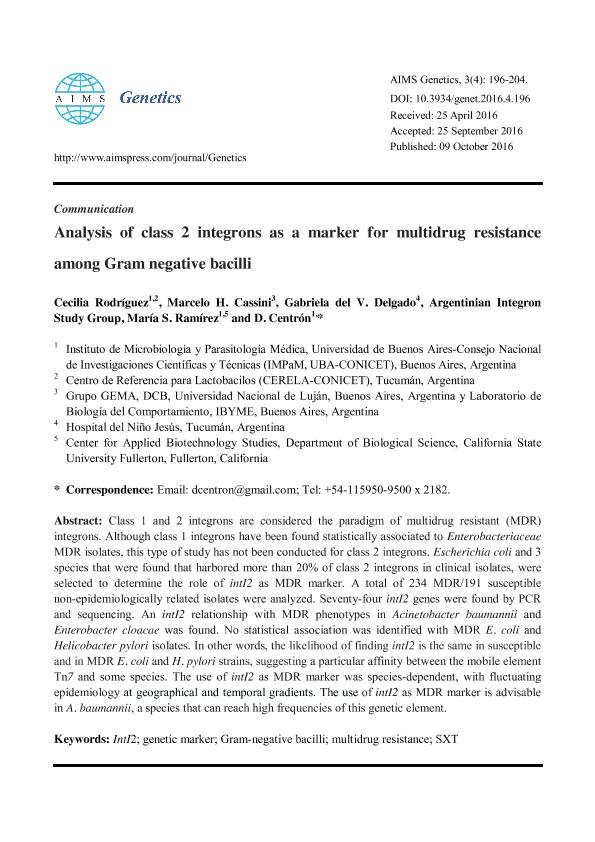Artículo
Analysis of class 2 integrons as a marker for multidrug resistance among gram negative bacilli
Rodriguez, Maria Cecilia ; Cassini, Marcelo Hernan
; Cassini, Marcelo Hernan ; Delgado, Gabriela del Valle
; Delgado, Gabriela del Valle ; Argentinian Integron Study Group; Ramirez, Maria Soledad
; Argentinian Integron Study Group; Ramirez, Maria Soledad ; Centron, Daniela
; Centron, Daniela
 ; Cassini, Marcelo Hernan
; Cassini, Marcelo Hernan ; Delgado, Gabriela del Valle
; Delgado, Gabriela del Valle ; Argentinian Integron Study Group; Ramirez, Maria Soledad
; Argentinian Integron Study Group; Ramirez, Maria Soledad ; Centron, Daniela
; Centron, Daniela
Fecha de publicación:
09/10/2016
Editorial:
AIMS Press
Revista:
AIMS Genetics
ISSN:
2377-1143
Idioma:
Inglés
Tipo de recurso:
Artículo publicado
Clasificación temática:
Resumen
Class 1 and 2 integrons are considered the paradigm of multidrug resistant (MDR) integrons. Although class 1 integrons have been found statistically associated to Enterobacteriaceae MDR isolates, this type of study has not been conducted for class 2 integrons. Escherichia coli and 3 species that were found that harbored more than 20% of class 2 integrons in clinical isolates, were selected to determine the role of intI2 as MDR marker. A total of 234 MDR/191 susceptible non-epidemiologically related isolates were analyzed. Seventy-four intI2 genes were found by PCR and sequencing. An intI2 relationship with MDR phenotypes in Acinetobacter baumannii and Enterobacter cloacae was found. No statistical association was identified with MDR E. coli and Helicobacter pylori isolates. In other words, the likelihood of finding intI2 is the same in susceptible and in MDR E. coli and H. pylori strains, suggesting a particular affinity between the mobile element Tn7 and some species. The use of intI2 as MDR marker was species-dependent, with fluctuating epidemiology at geographical and temporal gradients. The use of intI2 as MDR marker is advisable in A. baumannii, a species that can reach high frequencies of this genetic element.
Palabras clave:
Inti2
,
Genetic Marker
,
Gram-Negative Bacilli
,
Multidrug-Resistance
,
Sxt
Archivos asociados
Licencia
Identificadores
Colecciones
Articulos(CERELA)
Articulos de CENTRO DE REFERENCIA PARA LACTOBACILOS (I)
Articulos de CENTRO DE REFERENCIA PARA LACTOBACILOS (I)
Citación
Centron, Daniela; Ramirez, Maria Soledad; Argentinian Integron Study Group; Delgado, Gabriela del Valle; Cassini, Marcelo Hernan; Rodriguez, Maria Cecilia; et al.; Analysis of class 2 integrons as a marker for multidrug resistance among gram negative bacilli; AIMS Press; AIMS Genetics; 3; 4; 9-10-2016; 196-204
Compartir
Altmétricas



